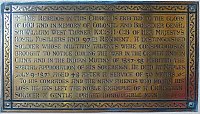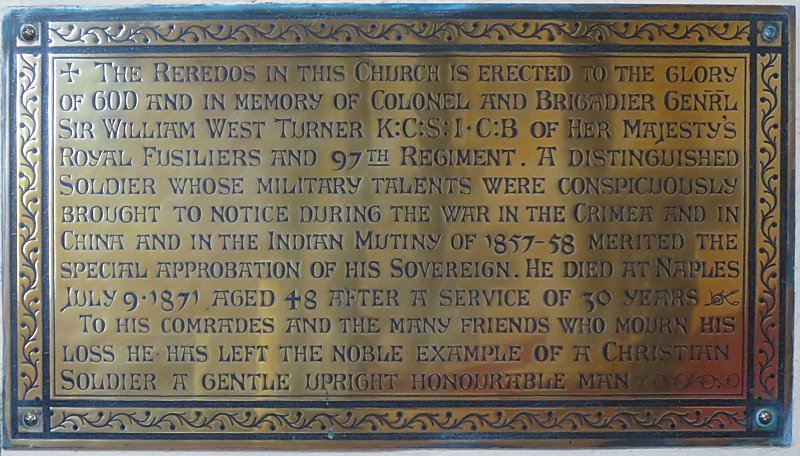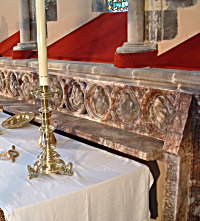The plaque is on the north wall to the left of the altar.
Size: 360mms high X 640mms wide.
Further Information
An obituary for Sir William West Turner was published in The Mercury (Hobart, Tasmania), published on Monday 11th September 1871. It read as follows:-
"Sir William West Turner entered the army as ensign 1841, became captain in 1853, major 1855, colonel in the army April 1859, appointed lieutenant colonel of the 97th foot, June 1859, served with the 20th Cameronians in China, and was present at the defence of Ningpo, the storm and capture of Chapoo, Woosung, and Shanghai, and the demonstration before Nankin, for which he received a medal, served with the 16th foot in Ceylon, and during the Kandian rebellion in 1848, served with the 7th Fusiliers at Sebastopol in 1855, and commanded a storming party there on the 7th June, when he was slightly wounded, was again wounded at an assault on the Redan, and was commandant of one of the fortresses there from December 1855, to June 1856, for which he received a medal and clasp, nominated a O B , was made a Knight of the Legion of Honour, received a Turkish medal, and the 5th class of the Medjidie, served in Bengal during the mutiny in 1857-8, and at the siege of Lucknow, was mentioned in the despatches of the commander-in-chief for his conduct at the action of Suhejnee, and 13 other minor affairs, and promoted to be colonel, was brigadier commanding the 2nd column of the Bundelcund field force from October to December 1859, and received a medal and clasp for the night attack of the enemy near Bomorio, November 1859 , appointed to command the 1st brigade of the EusoLje field force, December 1863, created a K.C.S.I. Sept 1867, for his long services in that country"
A reredos is an ornamental screen covering the wall at the back of an altar. At the Garrison Church this consists of a carved panel in Derbyshire Marble depicting nine figures with Our Lord in the centre and Mary Magdeline, St. John the Baptist, St. Mark and St. Matthew on his right whilst on his left are the Virgin Mary, Bishop Timothy, St. Luke and St. John.



